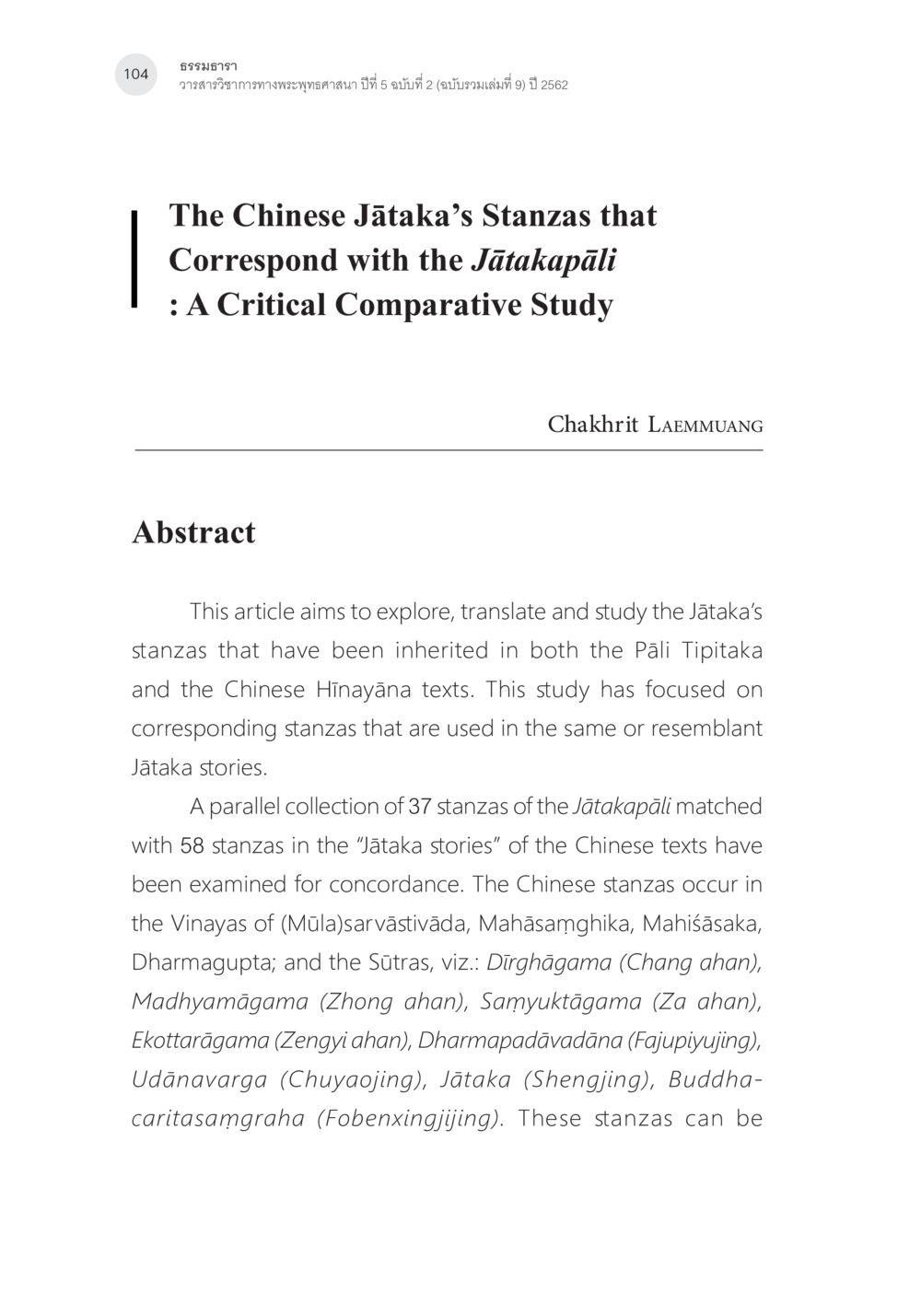การศึกษาเปรียบเทียบโคลงจากจาตุสดมภ์ในพระพุทธศาสนา : หน้า 5/74
คาถาชาดกพากย์จีนที่มีความสอดคล้องกับชาดกบาลี: ศึกษาวิเคราะห์เปรียบเทียบ : หน้า 5/74 ศึกษาการเปรียบเทียบโคลงจาตุกะจากภาษาปาลีและจีนในพระพุทธศาสนา
6 ครั้ง

สรุปเนื้อหา
บทความนี้มุ่งเน้นการสำรวจ แปล และศึกษาจากโคลงจาตุสดมภ์ที่สืบทอดในพระไตรปิฎกปาลีและบทที่เห็นในพระธรรมจีน การศึกษานี้ได้ตรวจสอบคู่โคลง 37 บทจากจาตุกะปาลีที่ตรงกับ 58 บทในเรื่องเล่าจาตาของจีน มีการศึกษาผ่านจากแหล่งประวัติศาสตร์ที่สำคัญจากคัมภีร์หลายเล่มและมีเป้าหมายในการศึกษาความสอดคล้องกันในแต่ละเรื่องซึ่งสามารถพบได้ในคัมภีร์ที่สำคัญต่าง ๆ
หัวข้อประเด็น
-การศึกษาโคลงจาตุสดมภ์
-การเปรียบเทียบระหว่างภาษาปาลีกับภาษาจีน
-บทบาทของจาตารในพระพุทธศาสนา
-สำรวจความสอดคล้องของโคลง
-เอกสารและแหล่งที่มาที่เกี่ยวข้อง
ข้อความต้นฉบับในหน้า
104
ธรรมธารา
ว่าวิสา วิภาวาททางพระพุทธศาสนา ปีที่ 5 ฉบับที่ 2 (ฉบับรวมเล่มที่ 9) 2562
**The Chinese Jātaka’s Stanzas that Correspond with the Jātakapāli: A Critical Comparative Study**
Chakhrit LAEMMUANG
**Abstract**
This article aims to explore, translate and study the Jātaka’s stanzas that have been inherited in both the Pāli Tipitaka and the Chinese Hīnayāna texts. This study has focused on corresponding stanzas that are used in the same or resemblant Jātaka stories.
A parallel collection of 37 stanzas of the Jātakapāli matched with 58 stanzas in the “Jātaka stories” of the Chinese texts have been examined for concordance. The Chinese stanzas occur in the Vinayas of (Mūla)sarvāstivāda, Mahāsāṃghika, Mahīśāsaka, Dharmagupta; and the Sūtras, viz.: Dīrghāgama (Chung ahan), Madhyamāgama (Zhong ahan), Samyuktāgama (Za ahan), Ekottarāgama (Zengyi ahan), Dharmapadāvadāna (Fajupiyujing), Udānavarga (Chuyaojing), Jātaka (Shengjing), Buddha-caritasamgraha (Fobenxingjijing). These stanzas can be
Tags : #จาตา #ภาษา #จีน #ปาลี #พระพุทธศาสนา #เรื่องเล่าจาตาร
หน้าหนังสือทั้งหมด
หนังสือที่เกี่ยวข้อง
Load More










































































